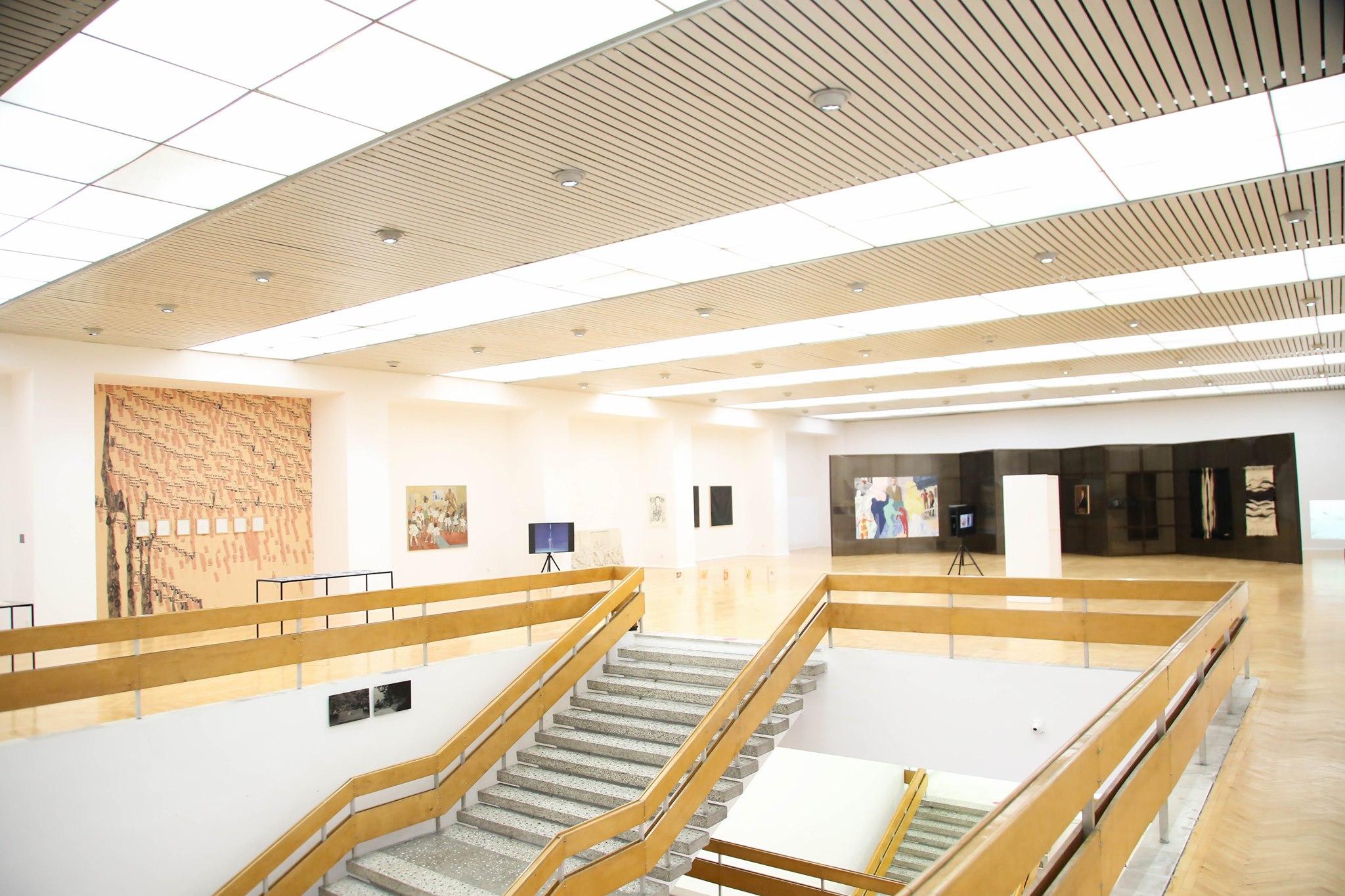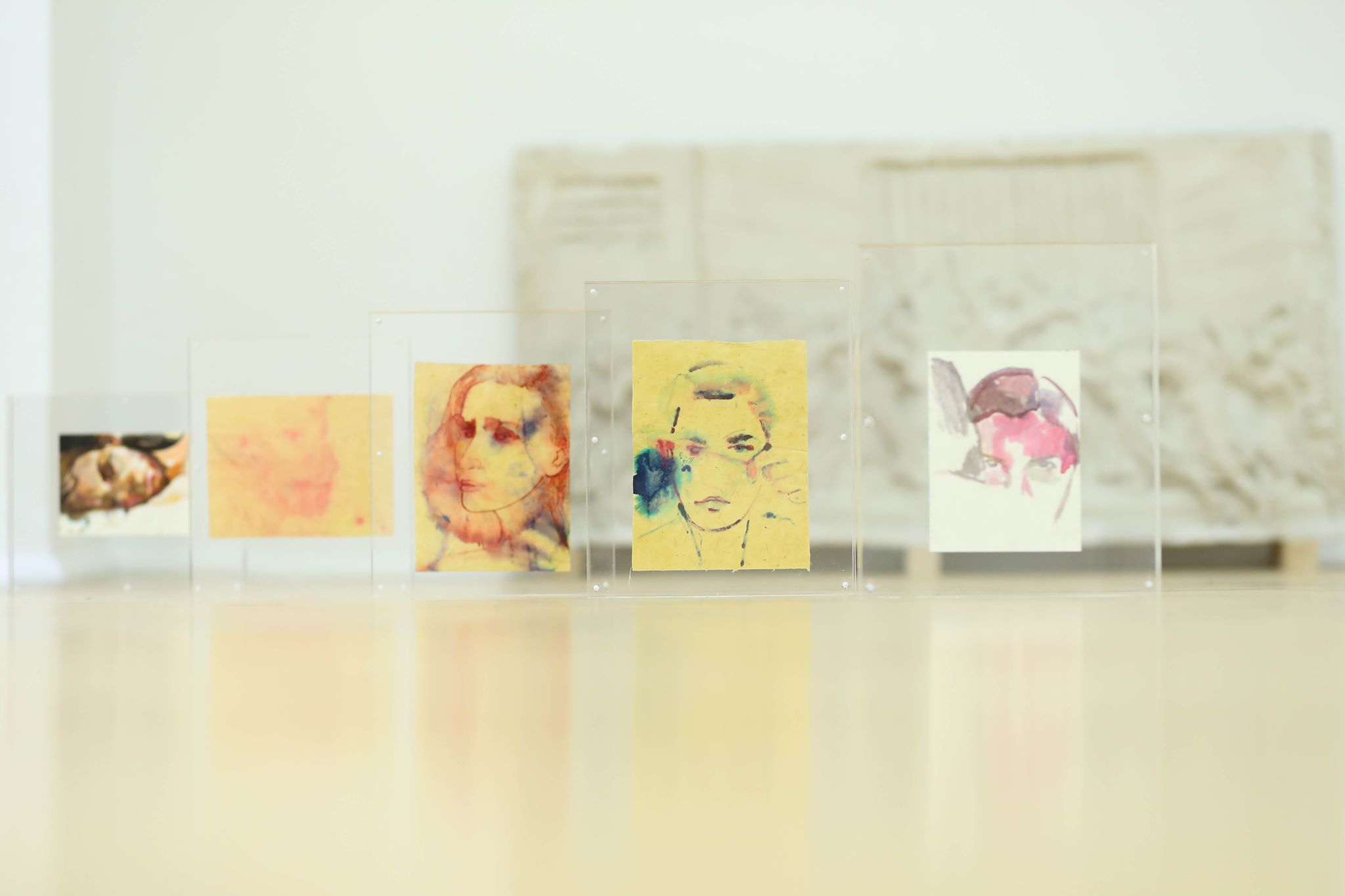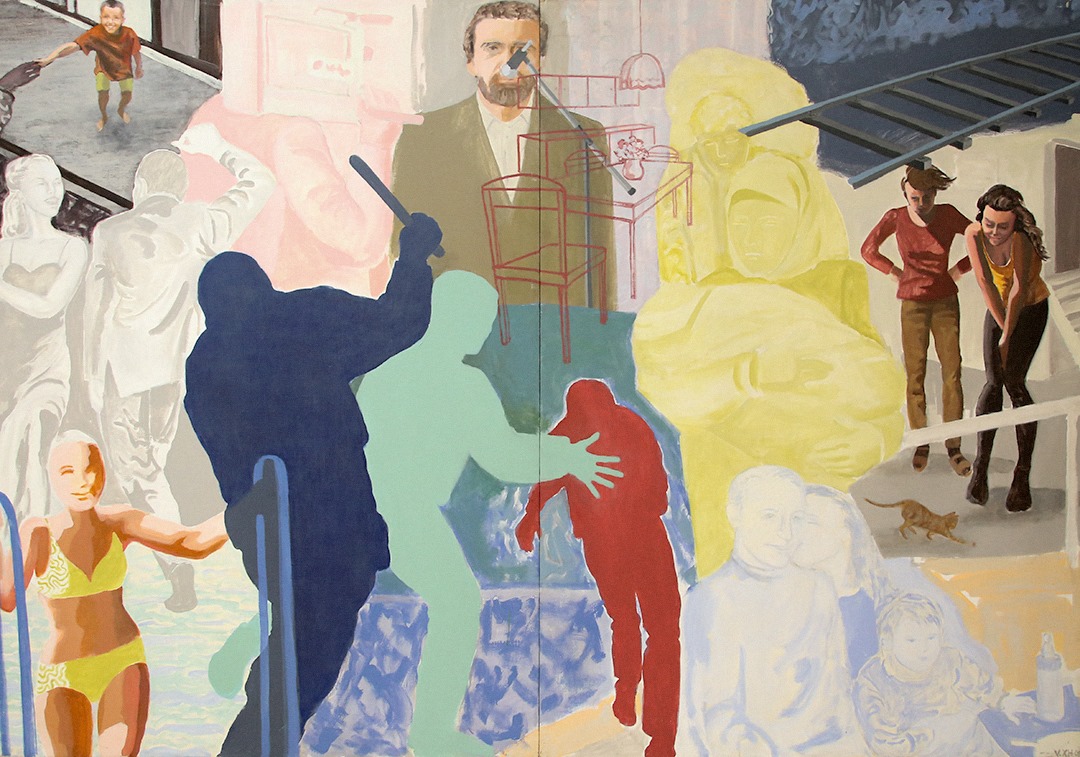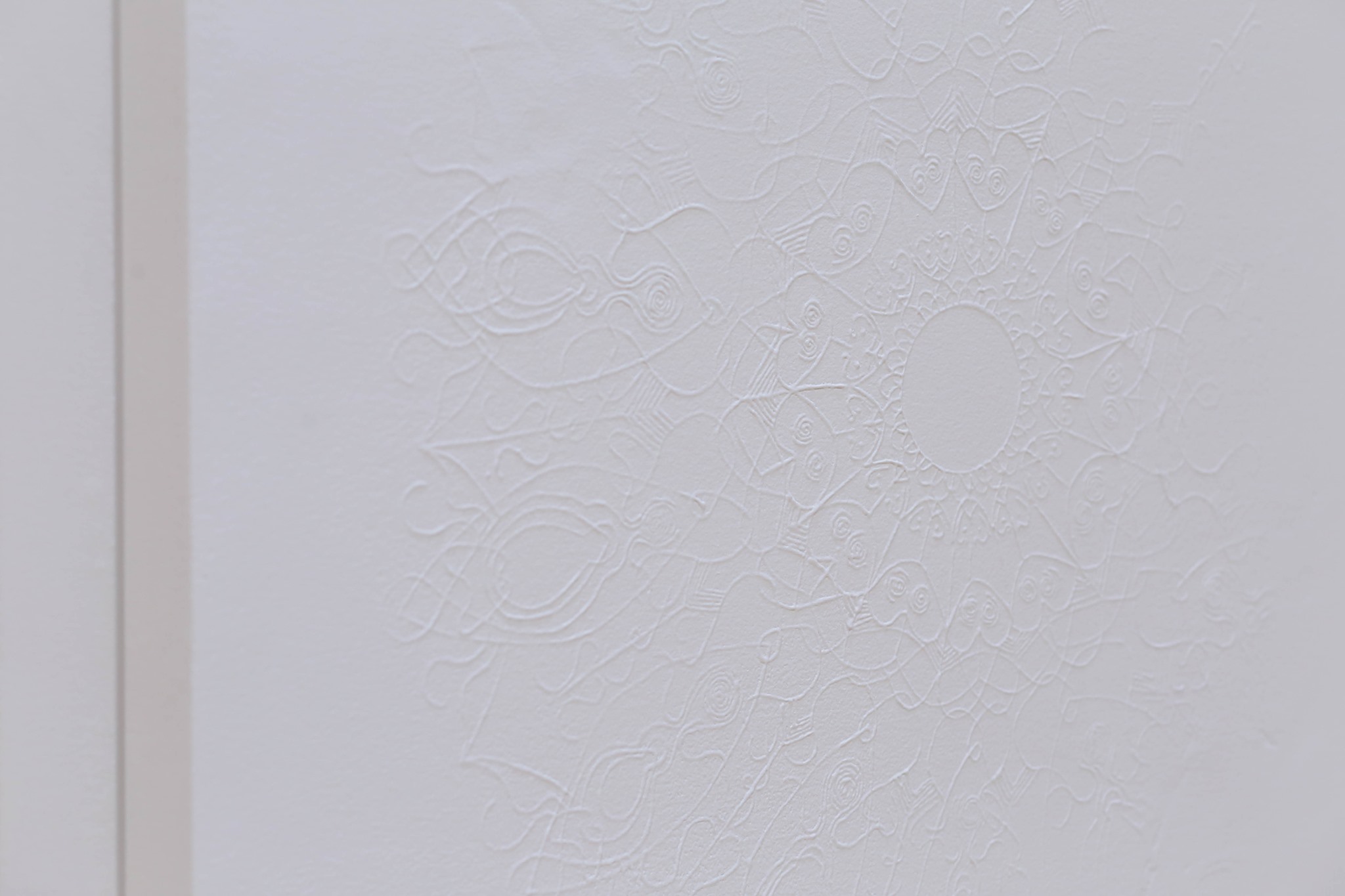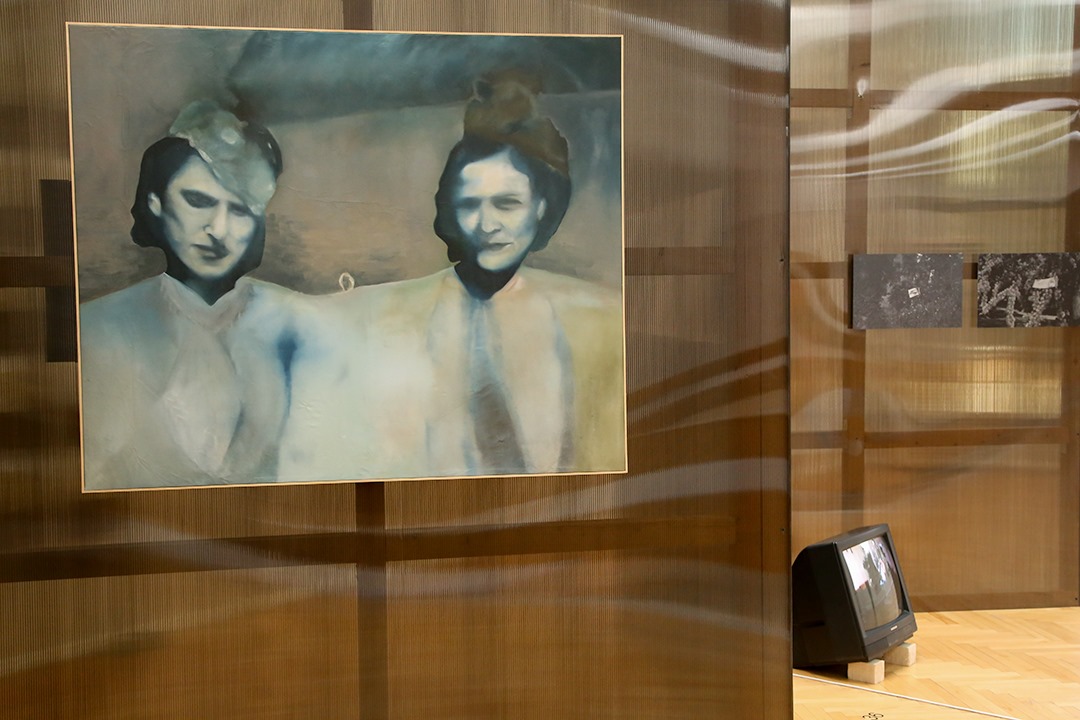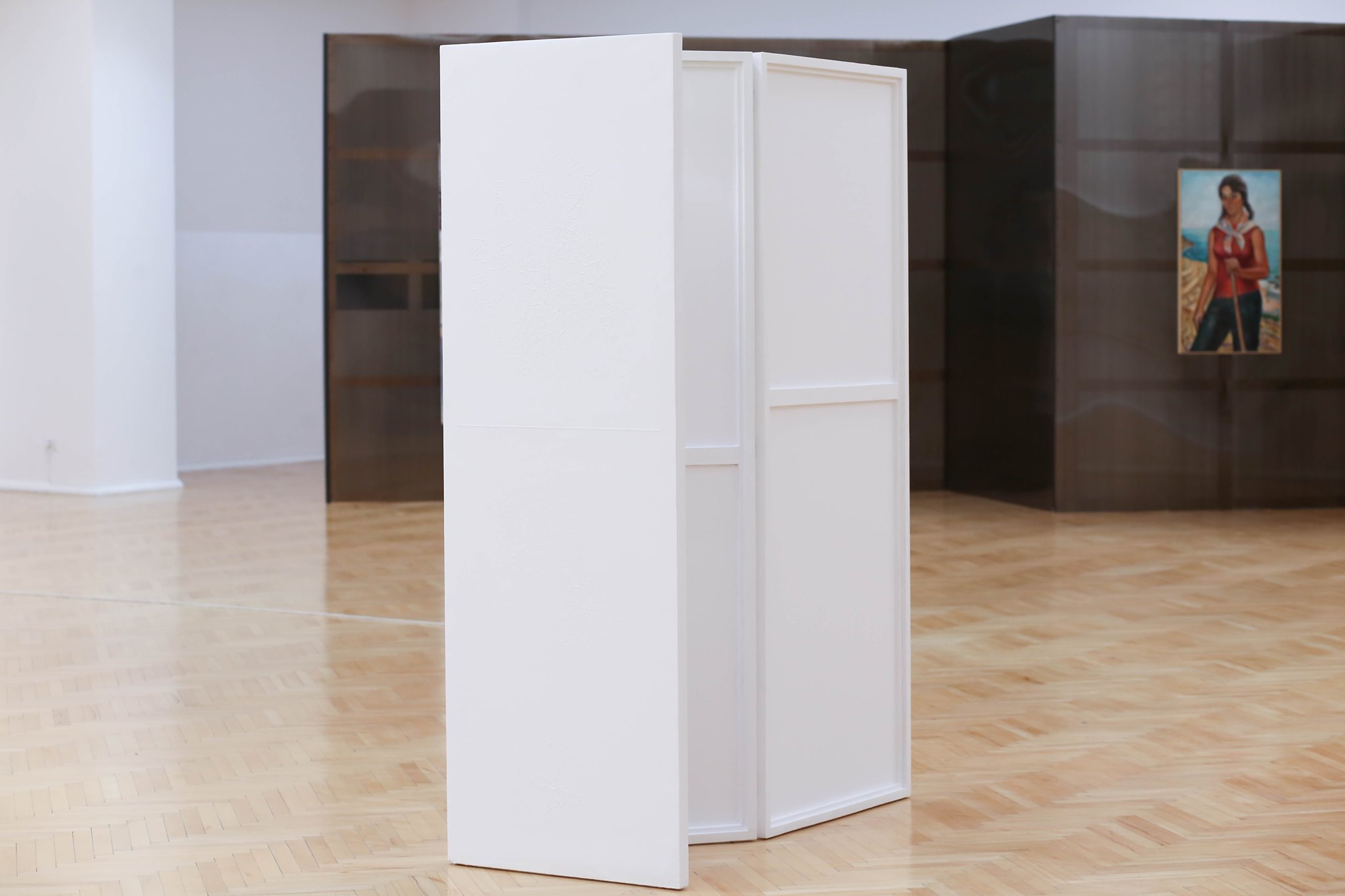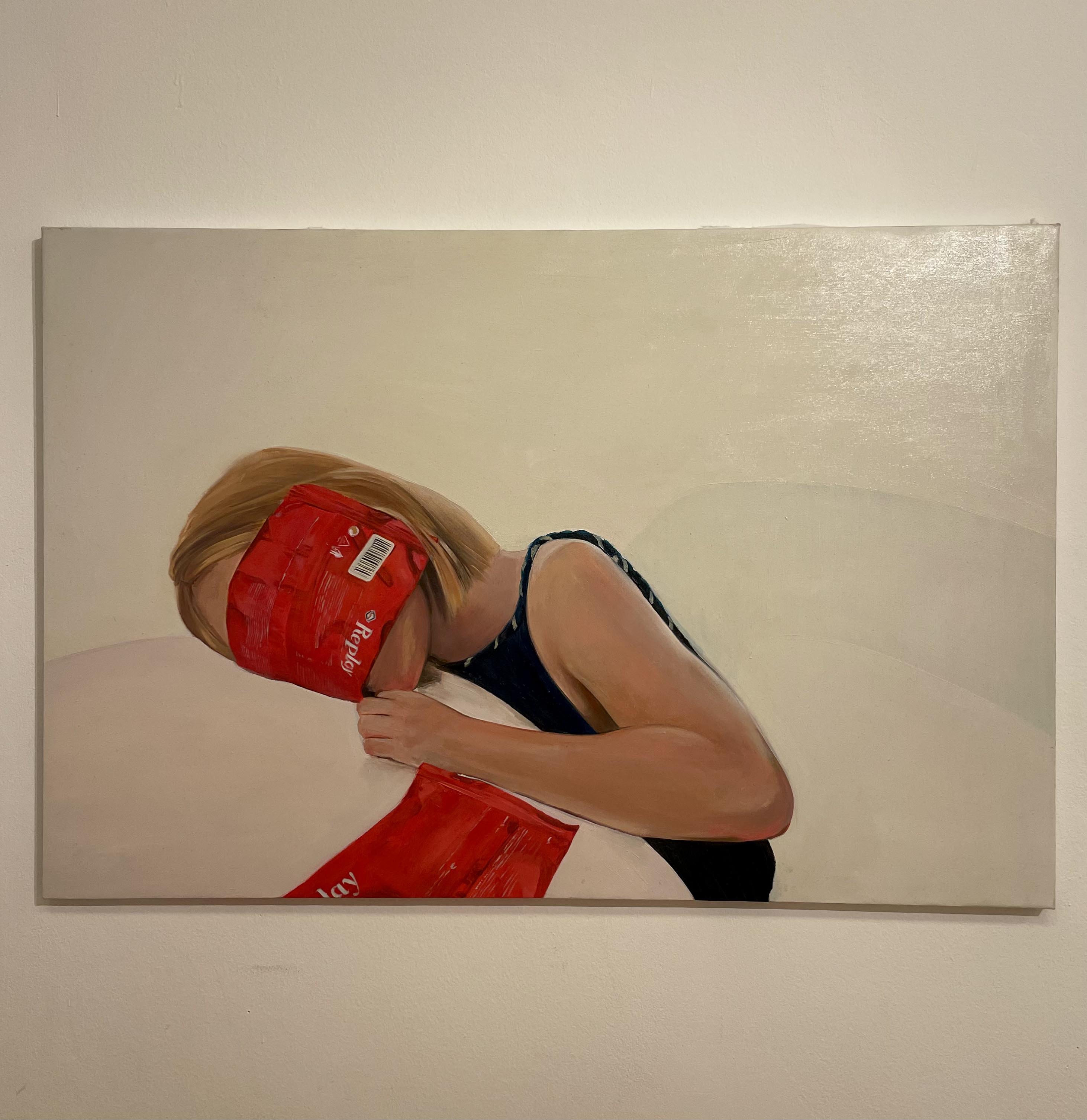
Exhibition / “Ambitions” / National Gallery of Arts / February 1st – April 1st, 2021 / Tirana
The National Gallery of Arts in Tirana receives in its space the “Ambitions” exhibition from February 1st to April 1st, 2021, – the fruit of a project developed in collaboration with the National Gallery of Kosovo, an exhibition which differs for its entirely female authorship, followed by female curation as well. These are Albanian artists from Albania, Kosovo and the Diaspora, whose works are displayed in this exhibition under the care of the curators: Adela Demetja and Erëmirë Krasniqi. The exhibition starts its journey in Tirana and then it concludes in Prishtina.
The “Ambitions” exhibition is an example of how the personal, the independent – in perspective and reflection (practically) – can live in harmony with the entity, thus creating a more resonant, inviting voice at the same time. The feminine feature of this exhibition seems to try and deepen the prominence of the role of women in art (visual art, in this case) in the eyes of the visitors; despite the general impression that the woman has been largely reflected by others and rarely reflective herself, when, in fact, the inherent reasons for her under-representation may have been: the lack of attention to her and her work, as well as the lack of her universal freedom.
The artistic experience of each of the authors, as a part of the narrative mosaic, is at the same time a reflective part of certain political and social periods, a bearer of a certain mentality and experience of a nation: in the Albanian space mainly, after the Second World War until today, although the exhibition does not follow the course of time. The works in question indirectly reflect the extensive conditions in which they were conceived and then came to life, and also the circumstances which the works were subjected to or they overcame. It would be inaccurate if we saw the exhibition focused on the feminist point of view. A number of authors and works may have aimed at confronting the patriarchy, but in their entirety they encompass a variety of themes, which gives the exhibition a note of universality.
The “Ambitions” exhibition is based in four axes:
a) Body archives (this axis focuses on the examination of the body, which is seen by the respective artists as the host and the follower of messages, and is used as a tool / weapon to reflect one’s worldview / attitude towards the world, in its political and social sense). The authors who adhere to this axis are:
Silva Agostini (“(A) Current State”, video); Alma Bakiaj (“I stayed inside my head for too long”, aquarelle on paper; “Ariel”, video); HAVEIT (“Baby blues”, performance); Blerta Hoçia (“I have so many eyes, beautiful eyes”, photo on aluminum plate); Shpresa Faqi (“Women drawing women”, workshop); Fitore Isufi – Koja (“Japonia” (Japan), video); Shelbatra Jashari (“Hello Shelly”, performance); Silvi Naçi (“Hard”, ceramic beans); Edit Pula(j) (“The last meters”, print ink, lithography on wall paper); Anila Rubiku (“Stitched dreams; embroidery on linen); Alketa Xhafa Mripa (“Mum, Am I a Barbarian?”, color photography).
b) The grammar of memory (this axis is another form of visual narrative which adheres to personal and common memory, recognizing and enhancing itself through the confrontation with the past. Despite the experiences at different times and places, the entirety of this subdivision creates the panorama of common problems). Relevant authors:
Lumturi Blloshmi (“The volunteer”, oil on canvas); Liljana Çefa (“The brave men in the museum”, oil on canvas); Donika Çina (“The A-side”, installation); Blerta Hoçia (“I have so many eyes, beautiful eyes”, photo on aluminum plate); Majlinda Hoxha (“In Tandem”, photo); Ledia Kostandini (“Aftermoments”, textile mosaic); Edona Kryeziu (“Greetings from an Elsewhere”, video); Hyrije Krypa (“Ganimete Tërbeshi”, graphic); Iva Lulashi (“Outside Underwear”, “Non ti preoccupare cara”, “Senza badare alla verita”, oil on canvas); Greta Pllana (“Untitled”, oil on canvas); Eli Xoxa (“The demonstration of the women of Tirana”, alto relief, gypsum); Violeta Xhaferi (“The journey”, acrylic pour diptych); Androniqi Zengo Antoniu (“Autoportrait”, oil on canvas).
c) Voluntary anachronisms (this axis constitutes a subdivision within the exhibition, which marks a feminine opposition to multifaceted conditioning, mainly based on gender). Authors of this section:
Flaka Haliti (“My balls”, video); Blerta Hoçia (“I have many eyes, beautiful eyes”, photo on aluminum plate); Shelbatra Jashari (“Series in motion”, color photography); Matilda Odobashi (“Lines that lie”, wall paper; “Untitled”, rapid on paper); Nurhan Qehaja (“The flag”, video); Alketa Ramaj (“Adam’s apple”, video); Miradije Ramiqi (“Archetype act”, “Illyrian archetypes”, oil on fabric); Alije Vokshi (“Composition 5”, “Breaking the boundary”, oil on fabric; “Drawing cycle”, rapid on paper); Rudina Xhaferi (“Rudinism”, painting on artificial nails).
d) Poetic summary (an axis which does not aim at all to the aesthetic fulfillment of the viewer / taster, but to the examination of the interior from one work to another). The following authors:
Brigita Antoni (“Dead End”, adhesive and video”; “Sketch Book”, rapidograph on paper); Bora Baboçi (“Triptych”, gypsum panels with gouache interventions and brushed plaster); Lirije Buliqi (“Vase”, “Dancing”, “The vases”, ceramic); Blerta Hoçia (“I have many eyes, beautiful eyes”, photo on aluminum plate); Majlinda Hoxha (“Sliding”, photo); Diana Miziri (“Composition”, mixed weaving); Alketa Ramaj (“Impurity”, industrial textiles); Merita Selimi (“Fading”, mixed technique on paper); Marina Sula (intervention); Sofia Zengo Papadhimitri (“Autoportrait”, oil on canvas); Valbona Zherka (“Silence”, classic weaving and knitting by handloom).
Apart from the long period of time, as well as the high number of participants, the exhibition presents: historical moments (starting from antiquity and from one generation to another); the state or the consequences of political regimes (there is no lack of the sensitivity with which these creative women have experienced freedom or restrictions from these regimes), recent political and economic developments; various human, social and gender issues, as well as the goal of the inclusion of society in solving these issues.
While searching for the feminine physical and mental balance, the creativity of this exhibition, in addition to the variety of its technical language, it transmits the effort of exploring oneself while walking through time, in relationships with oneself and others. Fragile emotional states are embodied in the exhibition through performances that convey an opposition to unacceptable social phenomena, which naturally causes the viewer to question the veracity of social progress; questioning the character development without losing femininity. All of this constitutes an introduction within the human nature, using art as a self-recognizing, reflective, and interactive experience with the other (society), through combining the delicacy of technique with the harshness of the content. From time to time, the creations openly prove the connection between the generations, the need to remember and understand past times and events, where the reconnection with the roots rises significantly while the essence of the exhibition remains the human, national and gender identity.
Sometimes fragile and sometimes harsh, these works are an undeniable evidence of the existence of women in the history of humanity and female art in the history of art (in this case, Albanian visual art). This testimony of women (artists) who have created for other women (heroines) is even more beautiful.
This ensemble of works turns down the notion according to which the artistic heritage bears only the male stamp. The works in question are not separated from the emptiness of the content, not even when some of them are just purely aesthetic; and the common denominator of this exhibition is the sensitivity with which the respective works are created, whereas the opposition to the masculine gender comes as a call for coexistence and cooperation.
About the curators:
* Adela Demetja is a curator and author. She was born in 1984 in Tirana (Albania) and studied at the Academy of Arts in Tirana (2002-2006). She, holds a master in “Curatorial and Critical Studies” of Städelschule and Goethe University, Frankfurt/Main Germany. Adela Demetja started her career as an artist. She is the director of Tirana Art Lab – Center for Contemporary Art, Albanians leading independent art institution, which she established in 2010. As an independent curator she has organized, managed and curated numerous international exhibitions and events in different European countries and the US. In 2016 she was appointed curator of Focus: Ex- Yugoslavia and Albania at viennacontemporary international art fair, Vienna Austria. In 2015 she co- curated the Third Edition of the International Contemporary Project Biennale D-0 Ark Underground taking place in the anti-atom shelter build by Tito in Konjic, Bosnia and Herzegovina. Some other exhibitions curated by Adela Demetja are: “The aesthetic of the small act”, at Action Field Kodra Festival in Thessaloniki, Voices of Truth, in Villa Romana in Florence, Italy. As an Author she has been writing exhibitions reviews, catalogue text and articles for different online platforms and publications in Albania and Europe.
* Erëmirë Krasniqi is a researcher and curator based in Prishtina. She graduated from Bard College Berlin in aesthetics, philosophy and literature and earned a Master’s degree in Comparative Literature from Dartmouth College. In Dartmouth, she has also worked as an assistant in several courses (Transnational Islamic Feminism, Krieger’s Virtual Wife: Japanese Anime and the Idea of Posthuman, Introduction to Film Study and Film noir), as well as a research assistant in the Media Ecology project. In 2017, Krasniqi completed the program “Exposure of contemporary history – Re-presentation of the XX century”, a one-year study on museology and curatorial practices at Friedrich Schiller University. Krasniqi is the executive director of the Kosovo Oral History Initiative, an independent organization based in Pristina.
***
Ekspozitë / “Synime” / GKA / 1 shkurt – 1 prill, 2021 / Tiranë
Galeria Kombëtare e Arteve në Tiranë mirëpret në hapësirën e vet, që prej 1 shkurtit deri më 1 prill 2021, ekspozitën “Synime” – fryt i një projekti të zhvilluar në bashkëpunim me Galerinë Kombëtare të Kosovës, ekspozitë e cila dallon për autorësinë tërësisht femërore, duke vijuar edhe me kurim femëror po ashtu. Bëhet fjalë për artiste shqiptare nga Shqipëria, Kosova dhe diaspora, veprat e të cilave vijnë në këtë ekspozitë nën kujdesin e kuratoreve: Adela Demetja dhe Erëmirë Krasniqi. Ekspozita e nis rrugëtimin e saj në Tiranë e më pas e përmbyll atë në Prishtinë.
Ekspozita “Synime” është një shembull se si vetjakja, e mëvetshmja – në këndvështrim dhe pasqyrim (praktikisht) – mund të qëndrojë në harmoni me të tërën, duke krijuar kështu një zë më kumbues, e më grishës njëherazi. Veçoria njëgjinore (femërore) e kësaj ekspozite, në njëfarë mënyre, duket sikur përpiqet të thellojë në sytë e vizitorëve spikatjen e rolit të gruas në art (artin pamor, në këtë rast); përkundër përshtypjes së gjithëhershme se gruaja ka qenë kryesisht e pasqyruar, e rrallëherë pasqyruese, kur, në të vërtetë, arsyet e qenësishme të nënpërfaqësimit të saj mund të ketë qenë: mungesa e vëmendjes ndaj saj dhe veprës së saj, si dhe mungesa e lirisë së gjithkahshme të saj.
Përjetimi artistik i secilës prej autoreve, pjesë e mozaikut rrëfyes, është njëkohësisht pjesëz pasqyruese kohësh të caktuara politiko-shoqërore, mbartëse e një mendësie dhe përvoje të caktuar të një kombi: në hapësirën shqiptare kryesisht, përkatësisht që pas Luftës së Dytë Botërore e deri më sot, ndonëse ekspozita nuk ndjek rrjedhën kohore. Veprat në fjalë pasqyrojnë tërthorazi kushtet gjithëpërfshirëse në të cilat janë ngjizur e më pas kanë marrë jetë, pse jo edhe ato rrethana kundrejt të cilave veprat u janë nënshtruar apo u kanë dalë përmbì. Dhe do të ishim të pasaktë, nëse leximi i ekspozitës do të përqendrohej në këndvështrimin feminist. Një numër i caktuar autoresh dhe veprash mund të kenë synuar përballjen e patriarkalizmit, por në tërësinë e tyre ato ngërthejnë llojshmëri temash, çka i jep ekspozitës nota universaliteti.
Ekspozita “Synime” bazohet në katër boshte:
a) Arkivat e trupit (bosht, i cili përqendrohet në shqyrtimin e trupit, i cili është parë nga artistet përkatëse si pritës dhe përcjellës kumtesh, dhe është përdorur si një mjet/armë për të pasqyruar botëkuptimin/qëndrimin vetjak ndaj botës, në kuptimin politik dhe shoqëror të saj). Autoret që i përmbahen këtij boshti:
Silva Agostini (“(A) Current State”, video); Alma Bakiaj (“Kam qëndruar shumë brenda kokës”, akuarel në letër; “Ariel”, video); HAVEIT (“Baby blues”, performancë); Blerta Hoçia (“Kam shumë sy, sy të bukur”, fotografi në pllakë alumini); Shpresa Faqi (“Gratë vizatojnë gratë”, punëtorì); Fitore Isufi – Koja (“Japonia”, video); Shelbatra Jashari (“Hello Shelly”, performancë); Silvi Naçi (“Fort”, fasule qeramike); Edit Pula(j) (“Metrat e fundit”, bojë shtypi, litografi në letër muri); Anila Rubiku (“Ëndrrat e qepura”, qëndisje në lino); Alketa Xhafa Mripa (“Mum, Am I a Barbarian?”, fotografi me ngjyra).
b) Gramatika e kujtesës (ky bosht është një tjetër mënyrë e rrëfimit pamor i cili i përmbahet kujtesës vetjake dhe asaj të përbashkët, duke njohur dhe rritur vetveten përmes përballjes me të kaluarën. Pavarësisht përjetimeve në kohë e vende të ndryshme, tërësia e kësaj nënndarjeje krijon panoramën e problematikave të përbashkëta). Autoret përkatëse:
Lumturi Blloshmi (“Aksionistja”, vaj në kanavacë); Liljana Çefa (“Fatosat në muze”, vaj në kanavacë); Donika Çina (“Ana A”, instalacion); Blerta Hoçia (“Kam shumë sy, sy të bukur”, fotografi në pllakë alumini); Majlinda Hoxha (“N’tandem”, fotografi); Ledia Kostandini (“Aftermoments”, mozaik tekstilesh); Edona Kryeziu (“Përshëndetje nga një tjetërkund”, video); Hyrije Krypa (“Ganimete Tërbeshi”, grafikë); Iva Lulashi (“Outside Underwear”, “Non ti preoccupare cara”, “Senza badare alla verita”, vaj në kanavacë); Greta Pllana (“Pa titull”, vaj në kanavacë); Eli Xoxa (“Demonstrata e grave të Tiranës”, altoreliev, gips); Violeta Xhaferi (“Rrugëtimi”, diptik, akrilik); Androniqi Zengo Antoniu (“Autoportret”, vaj në kanavacë).
c) Anakronizma të vullnetshëm (boshti në fjalë përbën në vetvete një nënndarje brenda ekspozitës e cila shënon një kundërshtim/kundërvënie femëror/e ndaj kushtëzimeve shumëkahëshe, kryesisht me bazë gjininë). Autoret e kësaj ndarjeje:
Flaka Haliti (“My balls”, video); Blerta Hoçia (“Kam shumë sy, sy të bukur”, fotografi në pllakë alumini); Shelbatra Jashari (“Seritë në lëvizje”, fotografi me ngjyra); Matilda Odobashi (“Vija të gënjeshtërta”, letër muri; “Pa titull”, rapid në letër); Nurhan Qehaja (“Flamuri”, video); Alketa Ramaj (“Molla e Adamit”, video); Miradije Ramiqi (“Akt arketip”, “Arketipe ilire”, vaj në pëlhurë); Alije Vokshi (“Kompozicion 5”, “Thyerja e kufirit”, vaj në pëlhurë; “Cikël vizatimesh”, rapid në letër); Rudina Xhaferi (“Rudinizmi”, pikturë mbi thonj artificialë).
d) Përmbledhje poetike (bosht, i cili nuk synon aspak përmbushjen estetike të shikuesit/shijuesit, por fund e krye tërheqjen në shqyrtimin e brendisë nga vepra në vepër). Autoret në vijim:
Brigita Antoni (“Dead End”, adeziv dhe video”; “Sketch Book”, rapidograf në letër); Bora Baboçi (“Triptik”, panele gipsi me ndërhyrje në guash dhe geso me penel); Lirije Buliqi (“Vazo”, “Valle”, “Vazot”, qeramikë); Blerta Hoçia (“Kam shumë sy, sy të bukur”, fotografi në pllakë alumini); Majlinda Hoxha (“Rrëshqitje”, fotografi); Diana Miziri (“Kompozim”, thurje e përzier); Alketa Ramaj (“Papastërti”, tekstil industrial); Merita Selimi (“Fashitje”, teknikë e përzier në letër); Marina Sula (ndërhyrje); Sofia Zengo Papadhimitri (“Autoportret”, vaj në kanavacë); Valbona Zherka (“Heshtja”, endje dhe thurje klasike me vek).
Duke u përveçuar nga një shtrirje e gjatë kohore, si dhe nga një numër i lartë pjesëmarrësesh, ekspozita paraqet: çaste historike (që prej lashtësisë e nga brezi në brez); gjendje apo pasoja regjimesh politike (nuk mungon ndjeshmëria me të cilën këto gra krijuese kanë përjetuar liritë apo kufizimet prej këtyre regjimeve), zhvillime të fundme politiko-ekonomike; problematika të ndryshme njerëzore, shoqërore dhe gjinore, si dhe synim për gjithëpërfshirje të shoqërisë në zgjidhjen e këtyre problematikave.
Në kërkim të drejtpeshimit trupor dhe mendor femëror, krijimtaria e kësaj ekspozite, përpos larmisë së gjuhës teknike me të cilën vjen, përcjell përpjekje për hulumtimin e vetvetes, duke ecur në kohë, në marrëdhënie me veten dhe të tjerët. Gjendje të ngarkuara psikologjike sendërtohen në ekspozitë përmes performancash që përcjellin kundërshtì ndaj dukurive të papranueshme shoqërore, çka i shkakton shikuesit natyrshëm pikëpyetje rreth vërtetësisë së përparimit shoqëror; pikëpyetje rreth zhvillimit të karakterit pa humbur feminilitetin. E gjithë kjo përbën një hyrje brenda natyrës njerëzore, duke përdorur artin si një përvojë vetënjohëse, pasqyruese dhe ndërvepruese me tjetrin (shoqërinë), përmes ndërthurjes së delikatesës së teknikës me ashpërsinë e përmbajtjes. Hera-herës, krijimet dëshmojnë hapur lidhjen mes brezave, nevojën për të kujtuar e kuptuar kohë e ngjarje të mëhershme, ku ngre krye ndjeshëm në to rilidhja me rrënjët teksa thelbi i ekspozitës mbetet identiteti njerëzor, kombëtar dhe ai gjinor.
Diku të brishta e diku të ashpra, këto punë janë dëshmi e pamohueshme e ekzistencës së femrës në historinë e njerëzimit dhe artit femëror në historinë e artit (në këtë rast, artit pamor shqiptar). Edhe më e bukur kjo dëshmi, kur gratë (artiste) kanë krijuar për gratë (heroina).
Kjo tërësi veprash thyen mendimin se trashëgimia artistike mban vetëm vulë mashkullore. Veprat në fjalë nuk përveçohen nga boshësia përmbajtësore, as kur ndonjëra prej tyre shëmbëllen thjesht estetike; dhe emëruesi i përbashkët i kësaj ekspozite është ndjeshmëria me të cilën janë krijuar veprat përkatëse, kurse kundërvënia ndaj gjinisë mashkullore? Ajo vjen si një thirrje për bashkëjetesë dhe bashkëpunim.
Rreth kuratoreve:
* Adela Demetja është kuratore dhe autore. Ka lindur më 1984 në Tiranë (Shqipëri) dhe ka studiuar në Akademinë e Arteve në Tiranë (2002-2006). Ajo ka ndjekur “Studimet kuratoriale dhe kritike”, në nivelin master, në universitetet “Goethe” dhe “Städelschule”, Frankfurt/Main (Gjermani). Adela Demetja e ka nisur karrierën si artiste. Në vijim, ajo ka drejtuar qendrën për art bashkëkohor “Tirana Art Lab”, të cilën e themeloi në vitin 2010. Si kuratore e pavarur, ajo ka organizuar, menaxhuar dhe kuruar një tërësi ekspozitash ndërkombëtare dhe ngjarjesh artistike në shtete të ndryshme të Europës dhe në SHBA. Në vitin 2016, ajo u emërua kuratore e “Focus: Ex-Yugoslavia and Albania” në panairin ndërkombëtar të artit “viennacontemporary” në Vjenë (Austri). Në vitin 2015, ajo ka bashkëkuruar edicionin e tretë të “International Contemporary Project Biennale D-0 Ark Underground”, që u zhvillua në strehimin antiatom të ndërtuar nga Tito në Konjic (Bosnjë dhe Hercegovinë). Ndër ekspozitat e tjera tematike të kuruara nga Adela Demetja, përmendim: “The aesthetic of the small act”, Festivali “Action Field Kodra” në Selanik (Greqi), “Voices of Truth”, Vila Romana në Firence (Itali). Si autore, ajo ka kryer shkrime për ekspozita, shkrime për katalogë dhe shkrime për platforma të ndryshme “on line”, të botuara në Shqipëri dhe Europë.
* Erëmirë Krasniqi është hulumtuese dhe kuratore me qëndrim në Prishtinë. Ajo është diplomuar në Bard College Berlin për estetikë, filozofi dhe letërsi, si dhe ka thelluar studimet në letërsinë krahasuese në Dartmouth College. Në Dartmouth, ajo ka punuar gjithashtu si asistente në disa kurse (Feminizmat islam transnacional, Gruaja virtuale e Kriegerit: Anime japoneze dhe ideja e post-humanizmit, Hyrje në studimin e filmit dhe Filmi noir), si dhe si asistente e hulumtimit në projektin Media Ecology. Në vitin 2017, Krasniqi përfundoi programin “Ekspozimi i historisë bashkëkohore – Riparaqitja e shek. XX”, studim njëvjeçar mbi muzeologjinë dhe praktikat kuratoriale në universitetin “Friedrich Schiller”. Krasniqi është drejtore ekzekutive e Iniciativës për Historinë Gojore, organizatë e pavarur me bazë në Prishtinë.

